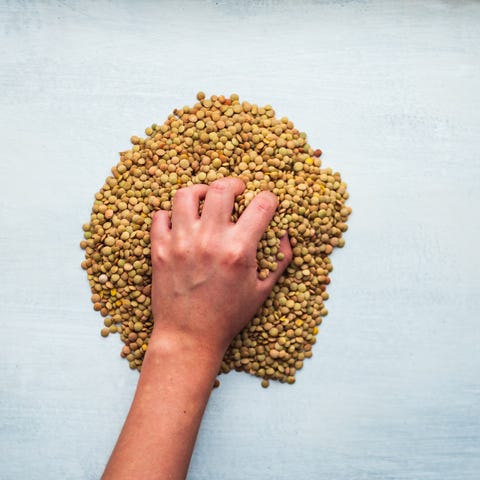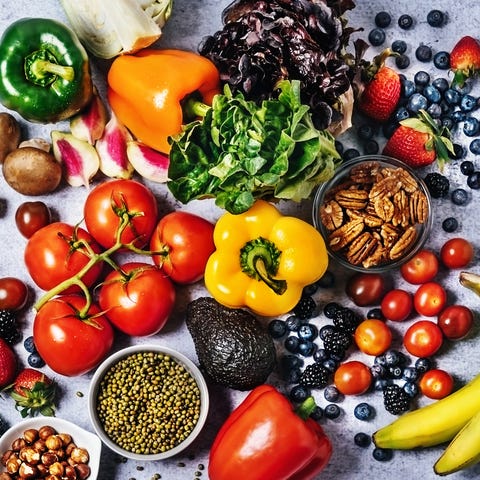Home » Diet & Food »
Pea Protein Is Everywhere Now. But Is It Even Healthy?
INSIDE A PROCESSING PLANT once used for dairy production in Turtle Lake, Wisconsin, a machine hoists a cloth sack holding 2,200 pounds of pea flour and slices it open, releasing a plume of pastel-yellow powder that descends into the hopper.
This is one of the least noisy rooms in an extremely busy facility, says Melanie Sumiec, a process engineer at Puris who is leading a virtual tour of the plant.
That powder, which comes from yellow split peas that have been hulled and ground, is now on a conveyor belt headed to a different section of the plant for its final transformation: isolating the precious protein powder that makes up the fake burgers, vegan shakes, and protein-packed, muscle-building snacks that are invading supermarket shelves now.

The pea-protein market is already worth an estimated $213 million, according to analysis by Grand View Research—and that’s expected to double by 2025, as plant-based diets continue to become more mainstream.
Puris is the largest pea-protein manufacturer in North America, and its CEO, Tyler Lorenzen, says the company’s joint venture with global food corporation Cargill has enabled it to build a new facility in Minnesota that will double production.
Good thing, too, because pea protein is about to be everywhere.
Beyond Meat creates its burgers and sausages from the ingredient. Ripple Foods crafts its plant-based milks, shakes, and frozen desserts from the stuff. PeaTos makes its signature snack in five flavors, with four grams of protein per serving. Supplement start-ups like Owyn and Ladder are churning out pea-protein powders.
So what’s driving all this growth? And what’s so revolutionary, or even healthy, about ingesting all these peas, anyway?
Where Did Pea Protein Come From?
SUPPLY AND DEMAND. Demand and supply. You have to look at both to understand why pea protein is so popular now.

First, cuisines across the planet have long depended on yellow peas as a staple in many dishes: Indian dal, Russian split-pea soup, and Chinese split-pea cake, to name a few.
And legumes like yellow peas are not only good for you; they’re good for the land, too. Their nitrogen-fixing qualities have rendered them an essential crop in many farming systems, big or small; they require less energy to grow than other crops, like wheat, corn, and soy.
Lorenzen says that was the reason his father founded the company that would eventually become Puris in the mid-’80s—to build a market for farmers who grew peas to enrich their soil.
Back then, manufacturers used yellow peas primarily in livestock feed or pet food, or sellers shipped the peas overseas. This didn’t make the farmers much money—and it didn’t make much sense to feed livestock a whole lot of plant-based protein to grow animal protein.
The major pea-protein players argue that their product can help reverse the inefficiencies of current U. S. agricultural practices by transforming plants into foods that Americans already love to eat, such as burgers and snacks. Or protein shakes.
Powderized yellow peas certainly deliver on protein. Two scoops of one popular brand, Naked Pea, carry 27 grams of protein, two grams of carbohydrates, and 120 calories. (By comparison, the same amount of Naked Whey contains 25 grams of protein, three grams of carbs, and the same number of calories.)

Pea protein is also typically less expensive than dairy-based whey. But even if you factor in familiarity, sustainability, cost, and nutrition, that’s often still not enough to create mass-market demand.
For that you need something else: hype.
And within the past few years, that hype has arrived in the form of “plant-based” diets.
Is Pea Protein Good for Plant-Based Diets?
PLANT-BASED EATING is trending for lots of reasons, says Karen Ansel, M.S., R.D.N., the author of Healing Superfoods for Anti-Aging.

For years, research has shown that plant-forward diets can improve your health by reducing the risk of heart disease, diabetes, and obesity.
But recently, “marketing has also been a huge driver of the popularity,” says Ansel. “Veggie burgers have been around for decades, but it really wasn’t until companies like Beyond Meat and Impossible Foods invested in national marketing campaigns starting around 2018 that plant-based meat suddenly seemed sexy.”
Celebrity influencers are also flexing their cultural might. Everyone from Colin Kaepernick to Russell Brand is going plant-based, and in the 2018 documentary The Game Changers, even Arnold Schwarzenegger said he was eating less meat.
That film, produced by director and vegan James Cameron, argued that eating animal products could harm athletic performance, hurt your heart, and impair sexual function.
(Men’s Health, through experts, went on to debunk these claims, many of which were based on outdated, faulty, or misinterpreted research.)
Couple the rise of vegan diets rebranding as “plant based” with a decades-long decline in milk consumption in the U. S. and you have a market hungry for nondairy alternatives.
And if newly minted plant-based, protein-focused CrossFitters can’t eat animal products, that leaves them with only a few options. Like peas.
Except that what’s lost in the discussion around this dietary shift is whether pea protein has all the benefits of animal-based protein. The answer demands a look into the geeky world of protein quality.
Is Pea Protein Good for You?
PLANT-BASED-DIET followers like to claim that their athletic performance actually improved when they cut out or cut back on animal products. (There is no concrete research to suggest plant-based diets are superior for sports performance.)

And in terms of muscle building specifically, plant-based protein powder is only just as good as whey or casein, both dairy-based.
Pea protein can help you build muscle mass post-workout, says Eric Helms, Ph.D., C.S.C.S., a sports physiology and nutrition research fellow at Auckland University of Technology in New Zealand.
But, he cautions, there are many ways to gauge whether a protein is “good.”
One is by checking its protein digestibility–corrected amino-acid score—a way to measure a protein’s amino-acid composition in relation to a person’s needs.
Helms says that whey protein scores 1, the gold standard, because it delivers all nine of the essential amino acids your body requires to build muscle. Pea protein is not far behind, at 0.8 or 0.9.
“The real question people want to know is: ‘If I’m a vegan or on a plant-based diet, will that lead me to sacrifice fitness or sports performance?’ And the data we have now says probably not,” says Helms.
But that’s only on the condition that you’re consuming a variety of foods that help provide the aminos you need, he says. If your diet is loaded with chips, cookies, and shakes, it won’t matter if they’re plant-based—or made with pea protein.
How Does Pea Protein Taste?
DESPITE THE FACT that Helms knows the research (and even conducted some of his own), he still prefers whey to pea protein.

“Whey has more than a decade of taste and texture engineering behind it,” he says.
It naturally dissolves more readily into liquids, it has an appealing milky taste, and then there are the flavors. Of a recent flavor of whey protein he tried, Helms says: “I was like, Did I just have a Butterfinger?”
While pea protein’s transformation from livestock feed into hot sports supplement has been rapid, its relative grittiness and plant flavor are sticking points for some consumers. Compared with whey protein, pea protein tends to give smoothies a “sludge-like” texture, says Helms.
And it tastes, well, like peas, says Stephen Zieminski, founder of Naked Nutrition. Zero taste is among the highest priorities for pea-protein makers. “I know pea protein gets a bad rap for grittiness and that earthy taste,” says Sumiec, the process engineer at Puris.
The company’s production process is designed to make the powder “bland in the best way possible.” To neutralize the somewhat polarizing natural taste of peas, Puris continues to refine an evaporation technique that may further improve, and ultimately eliminate, bitter flavors.
Until then, it’s up to other food scientists and start-ups to devise innovative flavor cover-ups. And some big-time players appear to be on the case as well.
PepsiCo continues to invest in the trend, adding pea protein to its Naked juices and Evolve milk line and, earlier this year, partnering with Beyond to develop new products. Could pea-protein-infused sports drinks or (big gulp) sodas be next?
This is all part of the process of “normalizing” the consumption of more plant-based ingredients, says Lorenzen. “I think one of the misconceptions people have is eating plants means eating a salad. But it could be a burger. This is a step in the right direction.”
Then again, there’s nothing wrong with a salad.
A version of this article originally appeared in the October issue of Men’s Health.
Source: Read Full Article



